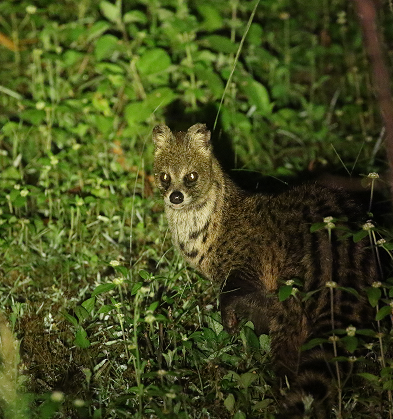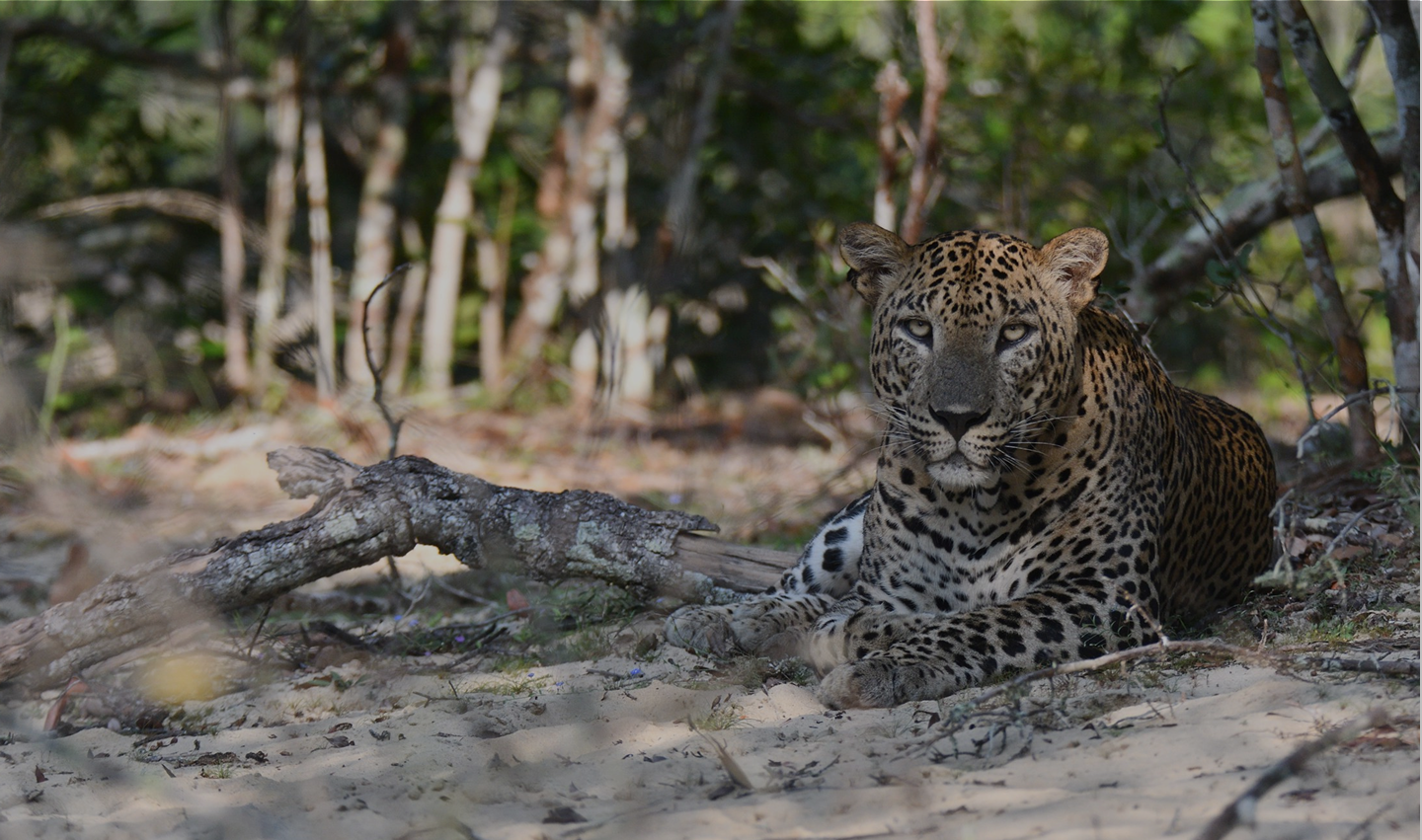
Mammals of Sri Lanka
Discover the wild heart of Sri Lanka — a tropical island teeming with rare and elusive mammals. From shy jungle dwellers to majestic forest giants, explore the rich biodiversity and ancient landscapes that make this island a sanctuary for nature lovers and wildlife adventurers.
Fur, Footfalls & Forest Echoes
Sri Lanka is a biodiversity hotspot and a must-visit destination for wildlife enthusiasts, home to a wide range of unique and rare mammal species. From the elusive Sri Lankan Leopard and the Purple-faced Langur to the nocturnal Red Slender Loris, these fascinating animals inhabit the island’s diverse ecosystems, including rainforests, grasslands, and montane forests. Sri Lanka’s rich mammalian diversity offers incredible opportunities for wildlife safaris, nature photography, and eco-tourism, making it one of the best places in Asia to experience wild mammals in their natural habitats.
Sri Lankan Leopard
Panthera pardus kotiya
The Sri Lankan leopard an endemic subspecies, reigns as the undisputed apex predator of the island and the crown jewel of Sri Lanka’s wildlife tourism. With no tigers, lions, or hyenas to compete with, these magnificent cats have developed distinctive behaviors and confidence rarely seen elsewhere, establishing Sri Lanka as Asia’s premier leopard-watching destination. Yala National Park boasts one of the world’s highest leopard densities (12-14 individuals per 100 km² in certain blocks), with Block I offering up to 75% sighting success during peak seasons.
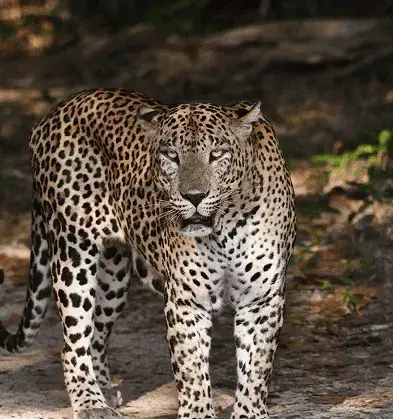
Sri Lankan Elephant
Elephas maximus
The Sri Lankan elephant a distinct subspecies of the Asian elephant, represents one of the island’s most iconic wildlife treasures. Distinguished from their African cousins by smaller rounded ears, concave backs, and single-fingered trunk tips, these gentle giants stand 2.5-3.0 meters tall with males weighing 3,000-5,000 kg. Recent surveys estimate Sri Lanka’s wild elephant population at approximately 5,800-6,000 individuals—nearly 10% of all remaining Asian elephants worldwide. While historically distributed across the entire island, today’s elephants primarily inhabit dry lowland regions, with a few isolated populations persisting in the highlands.
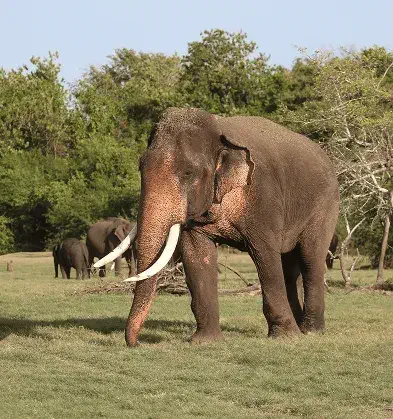
The Golden or Black-backed Jackal
Canis aureus
The Golden or Black-backed Jackal is a high-level carnivore primarily found in Sri Lanka’s lowland jungles, especially throughout the dry zone. These adaptable predators prefer hunting in open habitats like grasslands and scrub forests, typically moving in small packs or pairs. Their omnivorous diet includes lizards, birds, and small mammals, while they readily scavenge from carcasses and consume fruits and berries when available. Visitors can frequently spot these intelligent canids in Yala National Park, where they’re commonly seen, as well as in Wilpattu National Park, Udawalawe, and Bundala.
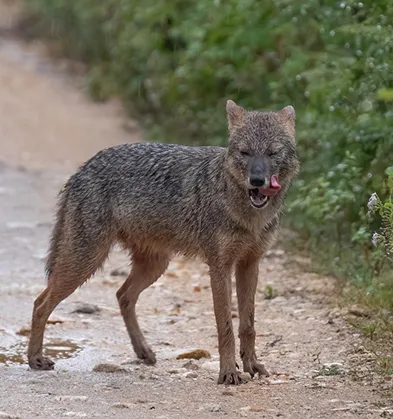
Fishing Cat
Prionailurus viverrinus
A remarkable medium-sized feline that can grow to the size of a dog, is distinguished by its distinctive facial markings—two white stripes bordering the eyes and prominent white patches on the cheeks. This semi-aquatic predator sports greyish fur adorned with broken longitudinal stripes along its sides and clearer stripes on its back. Primarily inhabiting wetland environments in both lowland and highland areas, these cats are exceptional swimmers and hunters, specializing in catching fish but also preying on small to medium-sized animals. Recent conservation studies indicate the species is classified as Vulnerable on the IUCN Red List, with populations declining due to wetland destruction, pollution, and poaching.
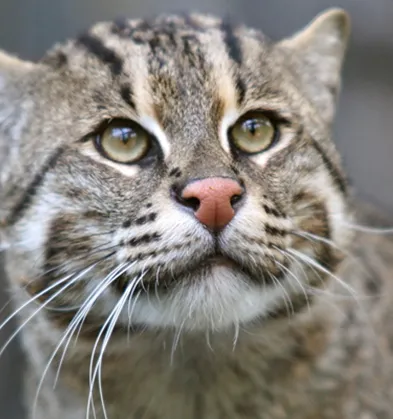
Purple-faced Leaf Monkey
Trachypithecus vetulus
The Purple-faced Leaf Monkey, endemic to Sri Lanka, is a naturally shy primate that typically avoids human contact but has adapted to urban environments due to its fondness for jackfruit commonly found in residential gardens. These arboreal creatures inhabit tall forests throughout the island except for the northern regions, organizing themselves into small family troops of approximately 12 members led by a dominant alpha male. While primarily folivorous (leaf-eating), they supplement their diet with various fruits. Several subspecies exist, including the distinctive “Bear Monkey” found exclusively in the Hakgala and Horton Plains National Park, characterized by its shaggy, longer fur.
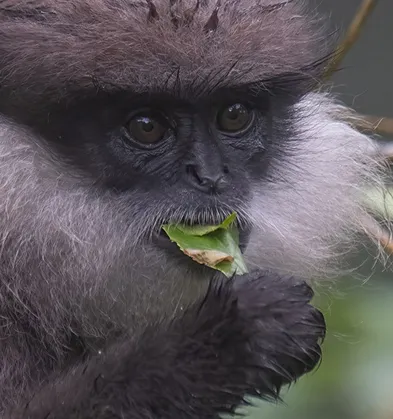
Indian Flying-fox
Pteropus giganteus
The Common or Indian Flying-fox is Sri Lanka’s largest bat, boasting an impressive wingspan of 1.2 meters. These remarkable creatures are easily identified by their fox-like faces with distinctive yellowish fur that contrasts sharply with their dark wings. Highly adapted to living near humans, they form large colonies that roost in tall trees, creating spectacular displays at dawn and dusk when they depart for feeding or return to rest. These bats feed exclusively on fruits and are frequent visitors to home gardens. Visitors can observe these fascinating mammals throughout Sri Lanka.
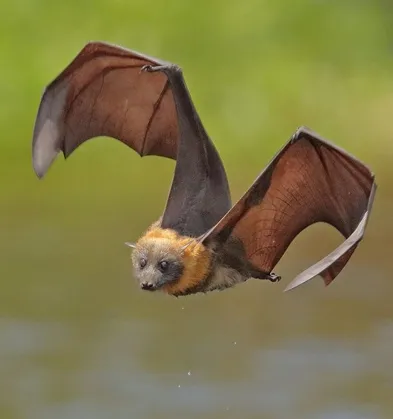
Toque Macaque
Macaca sinica
The Toque Macaque, Sri Lanka’s most commonly encountered monkey, frequently roosts in trees near human settlements across the island. Named for their distinctive “toque” or cap of radiating hair, these social primates organize themselves around dominant alpha males and stable female matrilines. As adaptable omnivores, they consume an impressive variety of plant materials and animal matter. Three subspecies exist across Sri Lanka’s varied ecosystems—dry zone, wet lowlands, and mountains—each distinguished by the color and length of their characteristic cap hairs.
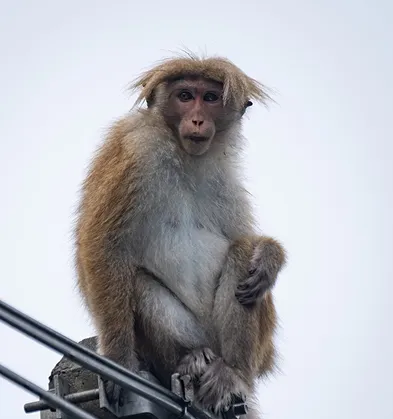
The Ruddy Mongoose
Herpestes smithii
The Ruddy Mongoose is a common sight in the southern lowlands of the island. While often confused with the Brown Mongoose, its distinctive black-tipped upward-curling tail makes identification easier. These carnivorous mammals typically travel in pairs through forested areas, where they hunt and scavenge for food. They’re frequently spotted near Leopard kills, taking advantage of these predators’ leftovers. For wildlife enthusiasts hoping to observe these fascinating creatures in their natural habitat, Yala National Park offers excellent viewing opportunities. Their adaptable nature and interesting behaviors make them a captivating subject for wildlife watchers exploring the region.

The Indian Muntjac or Barking Deer
Muntiacus muntjak
The Indian Muntjac or Barking Deer is a medium-sized deer characterized by its uniform brown coloration and small antlers mounted on distinctive pedicles. These shy creatures thrive where forest cover meets grasslands, inhabiting both lowland and highland regions across Sri Lanka. While typically solitary, they occasionally form small groups when predator threats are minimal. Their diet consists primarily of grasses and tender leaves. Wilpattu National Park offers the best viewing opportunities, though patient visitors might also spot them in Horton Plains National Park, Sinharaja Forest Reserve, and the quieter areas of Yala National Park. Early morning and late afternoon provide optimal sighting times when these cautious deer emerge to feed in forest clearings.
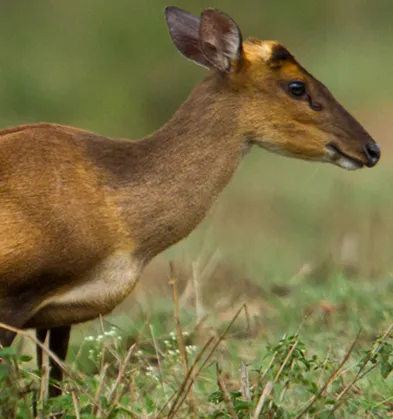
Sambar
Cervus unicolor
The majestic Sambar, incorrectly called ‘Elk’ by 19th century European hunters, reigns as Sri Lanka’s largest deer species. Easily identified by its uniform dark chocolate brown coat and impressive size, this adaptable creature thrives across diverse habitats from dense rainforests to open grasslands. Only males develop the distinctive antlers used in competitive battles for mating rights. Visitors can observe these magnificent animals in several Sri Lankan national parks, with the largest herds—sometimes numbering up to 30 individuals—found in the misty highlands of Horton Plains National Park.
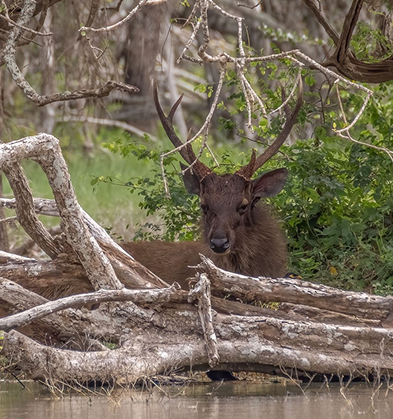
Hanuman or Grey Langur
Semnopithecus priam
The elegant Grey Langur, with its distinctive dark face and flowing tail, may occasionally be confused with the Purple-faced Leaf Monkey, though keen observers will note the Langur’s more graceful build. These social primates form groups of approximately 20 individuals and primarily inhabit Sri Lanka’s dry lowlands, where they feed on tender leaves and fruits. Displaying remarkable intelligence, they often strategically position themselves near Spotted Deer to benefit from additional vigilance against predators. Generally shy and peaceful around humans, these fascinating primates are most commonly observed in the cultural triangle of Sri Lanka—particularly in the ancient cities of Sigiriya, Anuradhapura, and Polonnaruwa.
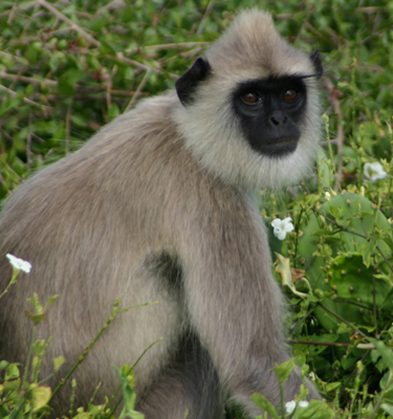
Rusty-spotted Cat
Prionailurus rubiginosus
The Rusty-spotted Cat holds the distinction of being Sri Lanka’s smallest wild cat and competes globally for the title of world’s smallest wild feline alongside the Black-footed Cat (Felis nigripes) and Kodkod (Leopardus guigna). With a slender frame smaller than a domestic cat, this diminutive predator features grizzled brownish-grey fur adorned with distinctive rusty-brown spots and two white facial stripes bordering the inner edges of its eyes. Its short legs support a compact body, while its moderately long, unmarked tail displays a more rusty coloration than the rest of its coat.
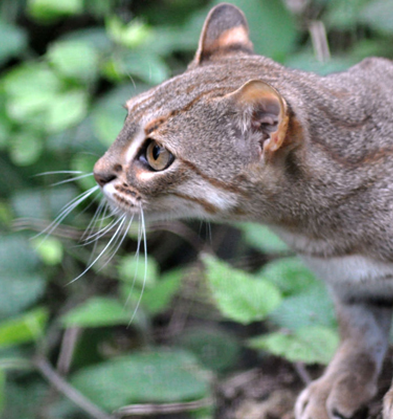
Jungle Cat
Felis chaus
The Jungle cat a medium-sized wild felid native to Sri Lanka, sports a distinctive sandy brown to grayish coat with striking black-tipped, pointed ears that create a characteristic rimmed appearance. Recent wildlife surveys indicate they primarily inhabit the island’s dry lowland scrub forests and grasslands, with notable populations in Yala, Wilpattu, and Bundala National Parks. Less adaptable to human presence than their cousin the fishing cat, jungle cats maintain territories ranging from 1-6 square kilometers depending on prey density. These solitary, primarily crepuscular hunters employ a stealthy stalk-and-pounce technique to capture prey.
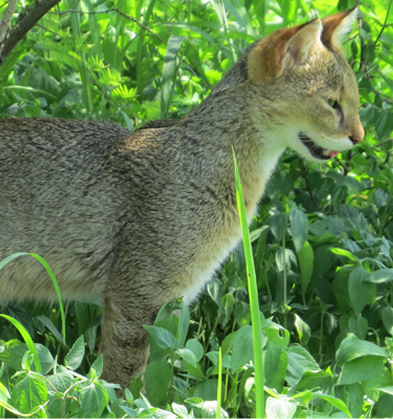
Indian Grey Mongoose
Herpestes edwardsii
The Indian Grey Mongoose is easily recognizable by its uniform grey grizzled fur and distinctive reddish eyes. As the smallest mongoose species in Sri Lanka, these nimble creatures can be found throughout the island, primarily inhabiting grasslands and lightly wooded areas. Though occasionally spotted in pairs, they tend to be shy around humans. The Indian Grey Mongoose follows an omnivorous diet, consuming fruits and roots while also hunting invertebrates and rodents. Their adaptable feeding habits and widespread distribution make them a resilient species within Sri Lanka’s diverse ecosystem, despite their typically elusive nature around human observers.
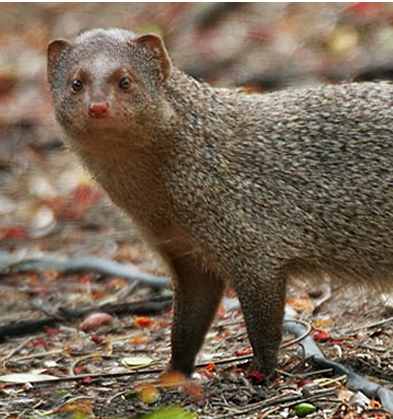
Gray Slender Loris
Loris lydekkerianus
The Gray Slender Loris exists in two distinct subspecies, with the Northern Slender Loris predominantly inhabiting Sri Lanka’s dry lowlands. This captivating nocturnal primate features a distinctive grayish coat complemented by yellow pigmentation around the ears, eyelids, and muzzle, along with characteristic oval dark patches encircling its large, forward-facing eyes. Commonly spotted in the historic regions of Sigiriya and Polonnaruwa, these curious creatures frequently venture into hotel gardens in search of their insect prey. Recent research reveals concerning population declines due to habitat fragmentation, road mortality, and illegal pet trade.

Red Slender Loris
Loris tardigradus
The Red Slender Loris is a distinctive primate smaller than its relative, the Gray Slender Loris, featuring more compact ears and an elongated muzzle. True to its name, this endangered nocturnal mammal displays a striking reddish coat with distinctive dark reddish circular markings surrounding its large, expressive eyes. These specialized primates are exclusively found within Sri Lanka’s wet zone forests, including the biodiversity hotspots of Sinharaja and Morapitiya. Their diet primarily consists of insects, though they occasionally consume other small animals. Recent conservation studies indicate critical population declines due to habitat loss, with fewer than 2,000 individuals estimated to remain in the wild.
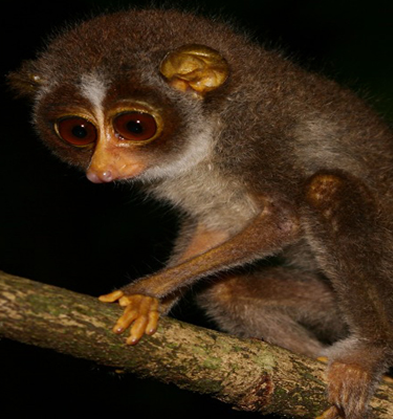
The Short-nosed Fruit Bat
Cynopterus sphinx
The Short-nosed Fruit Bat is one of four fruit bat species found in Sri Lanka, measuring up to 10 cm in body length. Distinguished by a variable reddish tinge on its back and nape—whose intensity differs based on age and sex—these agile creatures navigate entirely by vision and possess a remarkably keen sense of smell. They typically roost in small groups, showing a particular preference for palm trees. While common throughout the island, they’re especially prevalent in home gardens across the northern regions. Visitors can spot these bats in Jaffna Peninsula gardens, around Mannar Island, and in the coastal areas of Trincomalee.
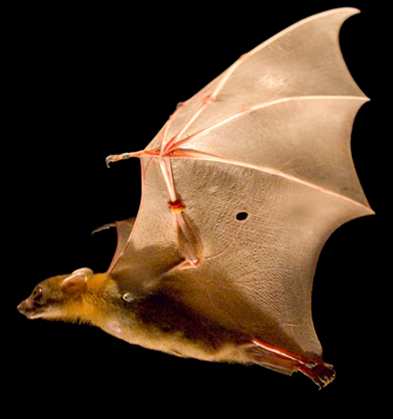
Black-naped or Indian Hare
Lepus nigricollis
The Black-naped Hare holds the distinction of being Sri Lanka’s only wild hare or rabbit species. This predominantly nocturnal mammal thrives in mixed habitats where forests meet grassy clearings, making it particularly well-adapted to the ecological transitions found on Colombo’s outskirts. A committed herbivore, it sustains itself by feeding on various grasses, tender shoots, and young leaves. Visitors hoping to spot these elusive creatures should explore wildlife sanctuaries such as Bundala National Park, Yala, and Wilpattu, where evening safari drives offer the best sighting opportunities. They can also be found in less protected areas including Talangama Wetlands and even some larger urban parks.
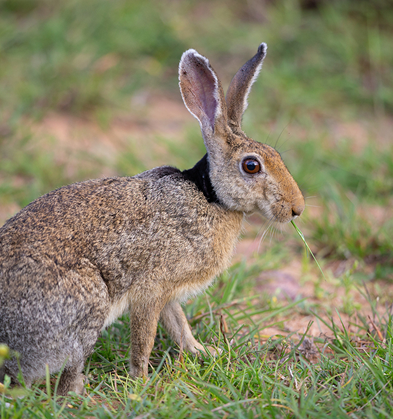
Crested Porcupine
Hystrix indica
The Crested Porcupine, an unmistakable creature with its blackish-brown and white coloration and impressive cloak of pointed quills, serves as a formidable opponent to predators who often bear these quills in their flesh long after failed attacks. Surprisingly adaptable to human environments, these nocturnal mammals are frequently spotted in urban areas during late night hours, particularly when escaping domestic dogs. Their resilience to human presence makes them bold enough to establish sleeping burrows even in home gardens. With a diverse herbivorous diet spanning roots, tender leaves, and fruits, these fascinating creatures can be observed across Sri Lanka.
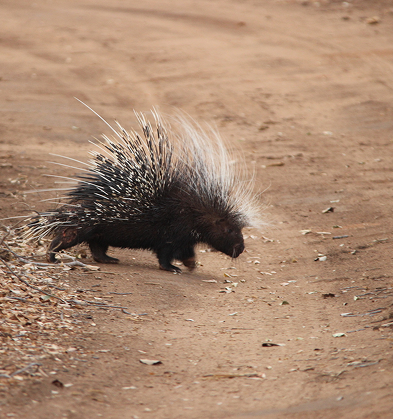
The Golden Palm Civet
Paradoxurus zeylonensis
The Golden Palm Civet is a slightly smaller relative of the common Palm Civet, distinguished by its beautiful reddish-golden fur. These highly nocturnal mammals make their homes in tall trees, where they typically live in pairs and find shelter in tree hollows. Their omnivorous diet includes a variety of fruits and berries, complemented by small animals such as birds, insects, and lizards. Wildlife enthusiasts hoping to spot these elusive creatures should consider visiting Sigiriya or Sinharaja Forest Reserve, where sightings are occasionally reported during night excursions. Their arboreal lifestyle and nocturnal habits make them one of Sri Lanka’s more challenging but rewarding wildlife encounters.
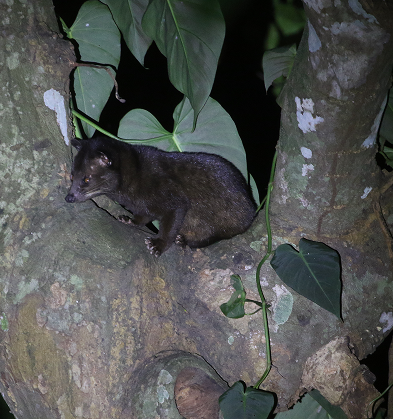
Otter
Lutra lutra
The Otter is among Sri Lanka’s most elusive mammals, with many locals unaware of its presence. This chocolate-brown, sausage-shaped creature features webbed feet perfectly adapted for aquatic hunting and a distinctive thick-based tail. While primarily nocturnal, these skilled predators occasionally appear during daylight hours, particularly around Hunas Falls. They inhabit unpolluted water bodies throughout the island, feeding mainly on fish but also opportunistically hunting aquatic animals and water birds. Visitors hoping to spot otters should explore Kanneliya Forest Reserve, Victoria Park in Nuwara Eliya, and the wetlands of Bundala National Park. Their reputation for raiding fish ponds makes them both fascinating wildlife and occasional nuisances to local gardeners.
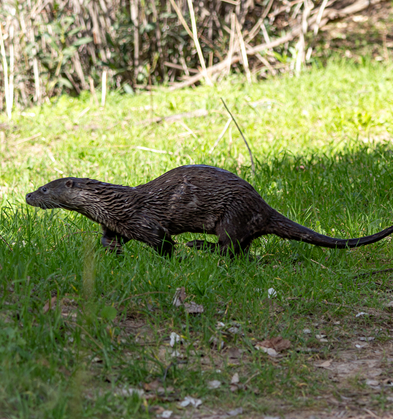
Giant Flying Squirrel
Petaurista philippensis
The Giant Flying Squirrel offers wildlife enthusiasts a truly magical spectacle as it gracefully glides between trees in Sri Lanka’s forests. This highly nocturnal creature features markings on its upper body similar to the black and yellow Giant Squirrel, complemented by distinctive pale underparts. Due to its secretive nighttime habits, these remarkable mammals remain challenging to spot and their social structure is still largely mysterious to researchers. For wildlife enthusiasts hoping to witness these elusive gliders in action, a known colony exists at a property in Kandy, where dusk provides the optimal viewing opportunity as they emerge for their nightly activities.
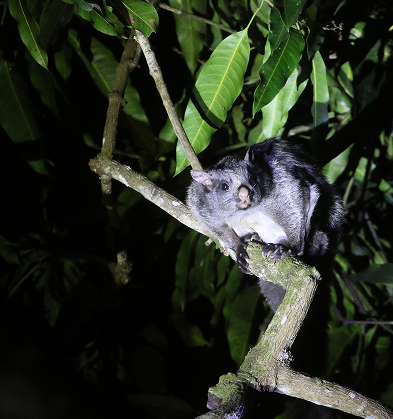
Sri Lankan Sloth Bear
Melursus ursinus inornatus
An endemic subspecies, is widely feared as the most dangerous wildlife encounter in the island’s forests. Recent surveys estimate only 500-700 individuals remain in Sri Lanka, classifying them as endangered. Distinguished by their shaggy black fur, elongated snout, and distinctive white V-shaped chest marking, these bears possess exceptionally powerful 10-12 cm claws evolved primarily for accessing termites. These formidable natural tools become dangerous weapons when the bears feel threatened. Research from the Wildlife Conservation Society indicates sloth bears are responsible for more human injuries than any other Sri Lankan wildlife, with approximately 10-15 serious encounters documented annually.
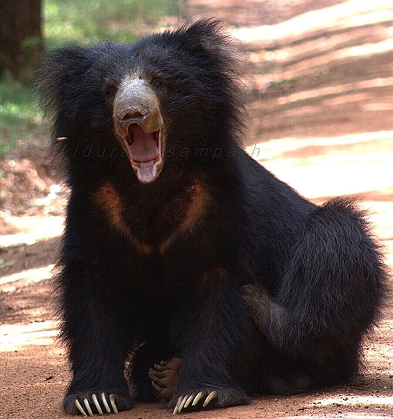
Grizzled Indian or Giant Squirrel
Ratufa macroura
Stands as the largest among Sri Lanka’s four squirrel species, impressing wildlife enthusiasts with its remarkable size and bold personality. Unlike many forest creatures, these charismatic mammals have become surprisingly comfortable around humans, often approaching visitors in hopes of securing a fruity treat. Typically observed in pairs, these arboreal acrobats require tall forest habitats to thrive and establish their impressive leaf nests. Sri Lanka hosts three distinct subspecies across different ecological zones: the highland variety showcases striking black and yellow coloration with a distinctive frosted white tail; the lowland subspecies features a completely black tail; while the dry lowland variety displays characteristic brown and buff fur.
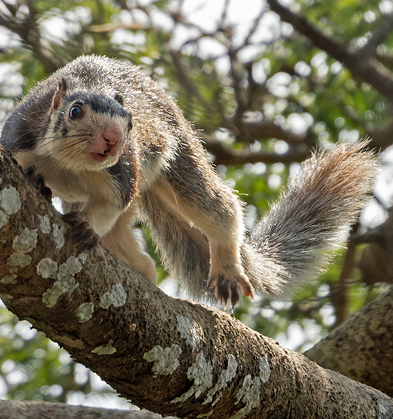
Common Palm Civet
Paradoxurus hermaphroditus
The Common Palm Civet also known as the Toddy Cat, is a highly adaptable nocturnal mammal found throughout Sri Lanka. With its sleek greyish fur and long flowing tail, this solitary creature moves with graceful agility. While females can be spotted with their young, adults typically live alone. Their omnivorous diet includes insects, rodents, and various fruits, contributing to their success in diverse habitats. Visitors can observe these fascinating animals in urban areas around Colombo and Kandy, as well as in natural settings like Sinharaja Forest Reserve, Yala National Park, and Horton Plains. They’re particularly active during early evening hours, often seen navigating along tree branches or rooftops.
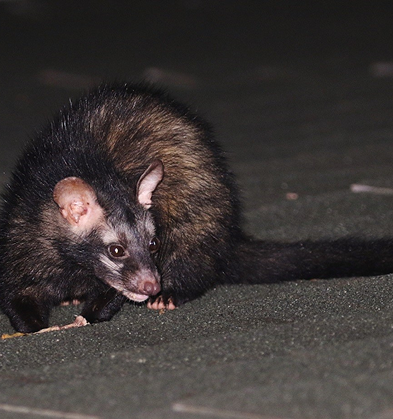
The Small or Ring-tailed Civet
Viverricula indica
The Small or Ring-tailed Civet is instantly recognizable by its distinctive black and white body and its namesake ringed tail. As the most carnivorous of Sri Lanka’s three palm civet species, it primarily hunts small rodents, hares, and mouse deer. These solitary creatures are typically spotted alone and have adapted to living in both roof spaces and tree hollows. Visitors have the best chance of spotting these nocturnal mammals during night safaris in Yala National Park, Wilpattu National Park, and Udawalawe National Park. They can also occasionally be seen in the forest edges around Sigiriya and in less disturbed forested areas throughout the central and southern regions of Sri Lanka.
